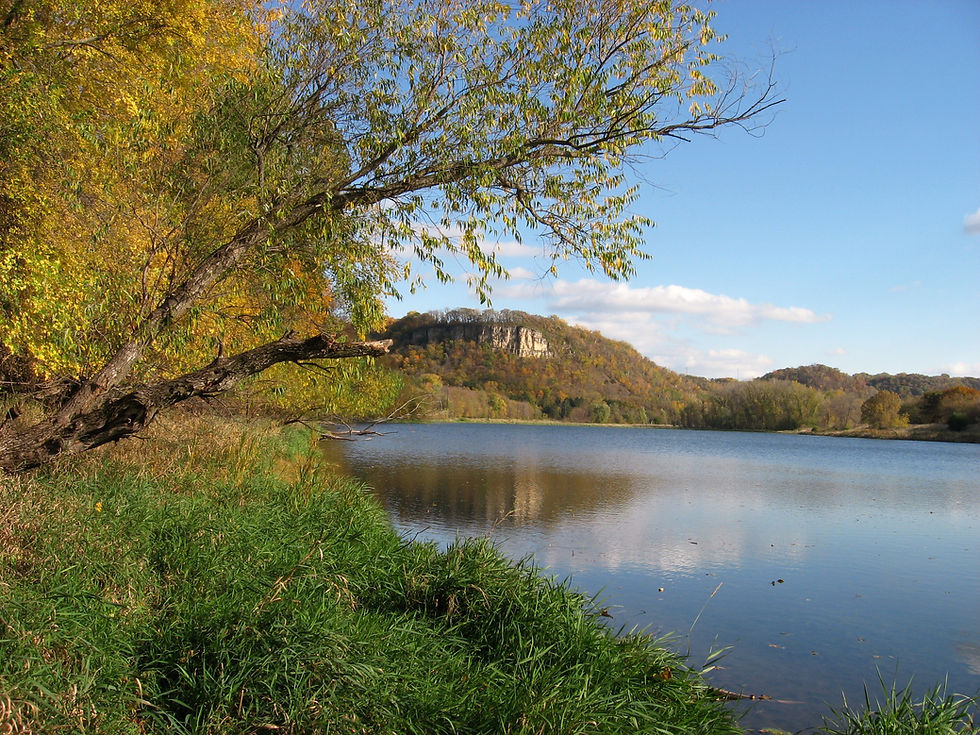Mississippi River, Dropping Like a Rock
- Bruce Ause
- Aug 13, 2018
- 3 min read

Dense Fog on the River
After experiencing abnormally high water levels approaching 12 feet all of June and the first half of July, the river has dropped precipitously to a more normal summer level of 4 feet the past ten days. With these low water levels and the fact that Wacouta Bay has filled dramatically in recent years, there is now only 3 to 12 inches of water in most of the bay. Early in the morning of August 12 in the midst of dense fog and smoke from forest fires in western Canada, I decided to paddle my solo canoe up into the bay and observe what wildlife was taking advantage of these low water conditions.

Blue Heron
The most obvious wildlife to be observed were numerous great blue herons. Because they tend to fly up ahead as I paddle along, it is difficult to obtain an accurate count. With that said, I still was able to count at least 12 herons from a single location. Some herons were high up in trees while others were standing along the edge of the water. These long-necked birds feed on fish and frogs as they wade the shallow water.

Green Heron
Another member of the heron family I observed was a green heron. These stocky birds usually hunch over their yellow legs at the water's edge. They are sometimes known to lure small fish in close by using small twigs or insects as bait.

Bald Eagle
Another interesting encounter on my paddle was of an adult bald eagle in the midst of consuming a good sized carp for a meal. Because this was a nice amount of food, the eagle was very reluctant to leave the area as I approached in my canoe. Notice the very efficient talons that these scavengers possess. Unlike golden eagles, they have no feathers on their talons. No doubt because they spend a good deal of time in the water securing food.

Solitary Sandpiper
Another interesting common shorebird I observed was the solitary sandpiper which spends most of it's time patrolling the edge of the water looking for insects and invertebrates to eat. They are seldom seen in large flocks and exhibit a habit of raising their wings after landing on the ground.

Ring-Billed Gull
Because the water level in the bay is so shallow, about the only place I observed clean fresh water was at the mouth of Bullard's Creek. This clean water had attracted several schools of small fish that in turn caught the attention of hungry ring-billed gulls.

River Otters
Not only had the schools of fish at the mouth of the creek attracted gulls, but also a pair of river otter who were feeding voraciously. Because the otter were preoccupied with the task at hand, I was able to approach them quite closely. They are fast efficient swimmers and frequently duck under the water. This made it a real challenge to find them in my camera. One saving grace for me was that they have a peculiar habit of being curious and sticking their heads up and out of the water.

Raccoon
There are a number of neighbors in Wacouta who are avid bird watchers and maintain very active feeding stations. I heard many stories throughout the summer about raccoons invading and in some cases destroying those feeders. I have been forced to meet that challenge by bringing my feeders in every evening. A couple weeks ago, we observed a raccoon in our backyard shortly before dark. The next thing we knew, it had climbed our one and only productive apple tree and was looking forward to a nightly feast.

Bank Erosion
On the evening of August 2, I took my friend Jim Chalmers canoeing down the Mississippi River starting at Colvill Park, through the Wisconsin backwaters and ending in Wacouta. When we came back into the main channel below 5th cut, we discovered a very disturbing sight. With high water levels this summer and the huge wakes created by large cruisers the shorelines had been severely damaged. I took this photo to document the problem. Without some no-wake protections at high water levels, the problem will only worsen. If the current situation continues, we can look forward to the river becoming wider and more shallow with increased sedimentation at the head of the lake.




Comments